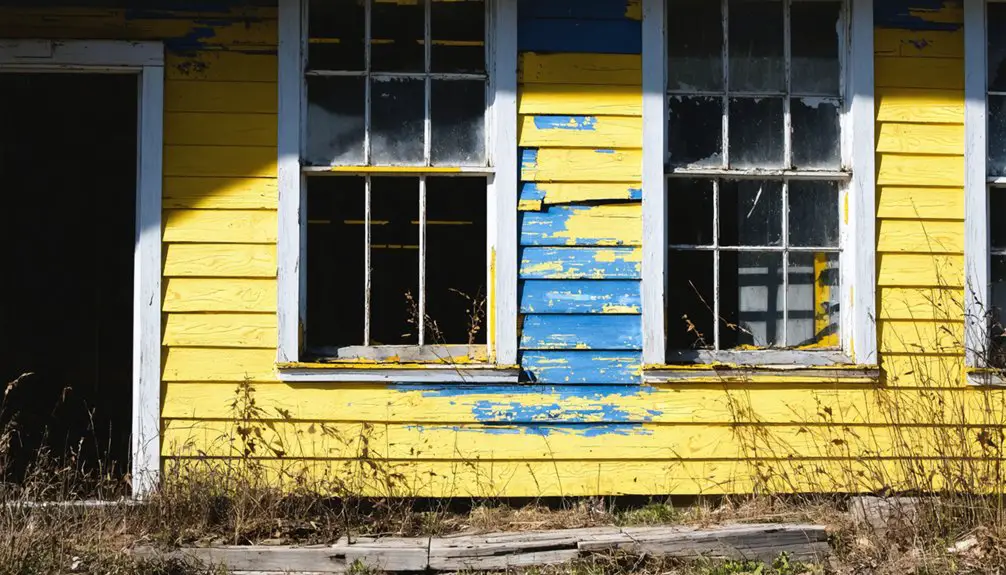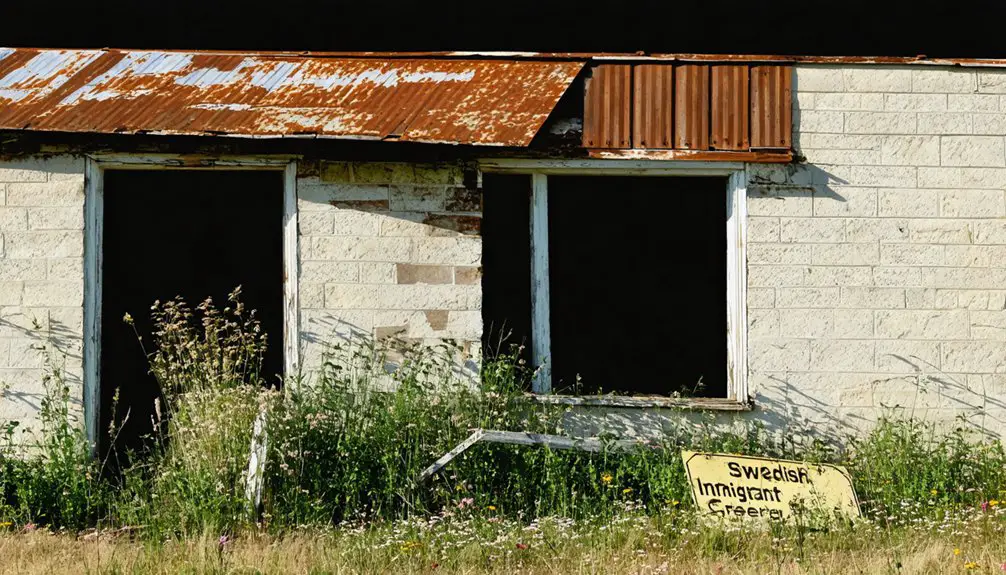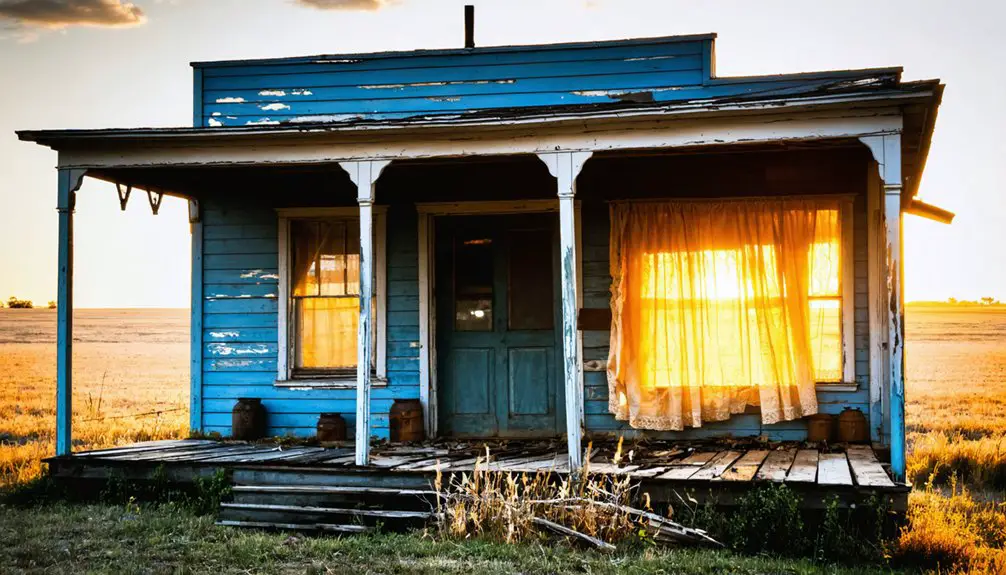You’ll find Sveadal, a ghost town in central Kansas, was founded in 1868 by Swedish immigrant Major Leonard N. Holmberg. He established a general store and post office, serving as both postmaster and justice of the peace. Despite his vision for a thriving Swedish-American community, Holmberg’s iron-fisted control and the settlement’s lack of essential infrastructure led to its decline. Today, no physical structures remain, though the story of this forgotten frontier town reveals fascinating insights into Swedish settlement patterns in Kansas.
Key Takeaways
- Sveadal was founded by Swedish immigrant Leonard N. Holmberg in 1868, centered around his general store and post office.
- The settlement failed to thrive due to insufficient infrastructure, lack of railroad access, and Holmberg’s controlling leadership style.
- Poor agricultural conditions and dependence on neighboring communities for basic services contributed to the town’s eventual abandonment.
- No physical structures remain of Sveadal today, with the former townsite completely reverting to agricultural land.
- The ghost town represents the broader pattern of failed Swedish-American settlements in Kansas during the late 1800s.
The Founding Vision of Major Leonard N. Holmberg

When Major Leonard N. Holmberg arrived in Kansas in 1868, he carried both his Swedish military background and immigrant aspirations to the untamed frontier.
Drawing on his claimed Swedish royal lineage and experience as a Union Army major, he established Sveadal as a manifestation of his cultural connections with the homeland.
You’ll find that Holmberg’s vision went beyond mere settlement. He strategically positioned Sveadal on his property, opened a general store, and secured his authority as postmaster and justice of the peace. Like most of his countrymen, he was among the working class immigrants seeking better economic opportunities in America.
His leadership style reflected his military past – maintaining order through armed presence and strict oversight. While his methods proved controversial, they aligned with his ambitious dream of creating a thriving Swedish-American community in central Kansas, though that dream would ultimately fade as Sveadal became a ghost town. The first courthouse meeting took place in his general store on March 6, 1870, marking a brief period of promise for the settlement.
Swedish Heritage in the Kansas Prairie
Throughout the mid-1850s, Swedish immigrants transformed the Kansas prairie into a mosaic of thriving ethnic communities, starting with pioneer John A. Johnson in 1855.
You’ll find their migration stories woven into settlements like Lindsborg and Scandia, where Swedish customs flourished through Lutheran churches and community celebrations.
These pioneers showcased remarkable resilience, breaking tough prairie sod and building homes from whatever materials they could find. Their agricultural practices evolved from modest beginnings with few livestock to established farmsteads across fertile valleys. John P. Swenson demonstrated this resourcefulness when he made his first home in a hollow log shelter.
Swedish settlers tamed the wild Kansas prairie, transforming raw land into prosperous farms through unwavering determination and resourceful spirit.
Prairie folklore tells of their determination through wildlife encounters and harsh conditions. Despite challenges, they preserved their heritage through language influences in their churches, stores, and social gatherings. In 1869, Pastor Olof Olsson led a significant group of pietistic Swedes from Värmland to establish the community.
Places like Bethany College became cornerstones of Swedish-American culture, bridging Old World traditions with prairie life.
Early Development and Infrastructure
As Major Leonard N. Holmberg established Sveadal in 1868, you’d find the settlement’s infrastructure centered almost entirely around his general store, which doubled as the local post office.
The early development faced significant settlement challenges, lacking the public buildings and utilities you’d expect in a growing frontier town. Like many towns that faced bad weather conditions, Sveadal struggled to maintain consistent agricultural production. Similar to Marshall, Kansas, many buildings were eventually relocated as residents left the failing settlement.
Unlike other Swedish settlements in central Kansas, Sveadal’s infrastructure limitations held it back from the start. You wouldn’t find railroad connections or major roads, and the town’s layout remained rudimentary, following typical pioneer patterns of the late 1860s.
The settlement’s growth depended heavily on Holmberg’s property and store as the commercial hub, but without essential services or proper development, Sveadal struggled to attract and retain settlers in those vital early years.
The Iron-Fisted Rule of the Town’s Justice
Shortly after establishing Sveadal, Major Leonard N. Holmberg secured his appointment as justice of the peace in 1869. He’d claimed a noble Swedish heritage and Civil War service, while simultaneously holding positions as postmaster and justice.
Holmberg’s intimidation tactics defined his rule, as he regularly brandished a firearm to control farm laborers and enforce his personal brand of justice. Like other Kansas towns that experienced planned attacks, tensions between Holmberg and the townspeople occasionally led to threats of violence.
His iron-fisted approach created a climate of community fear, with residents living under constant tension. Without formal court processes or checks on his authority, Holmberg’s arbitrary power went unchallenged. The town’s isolation mirrored that of Geuda Springs, which sat along the edge of the county with minimal outside oversight.
You’ll find his legacy deeply woven into Sveadal’s eventual decline, as his heavy-handed enforcement discouraged community development and undermined social cohesion. This style of frontier justice, common in isolated settlements, ultimately contributed to Sveadal becoming a ghost town.
Daily Life in Frontier Sveadal
Life in frontier Sveadal centered primarily around Holmberg’s general store and the surrounding farmland, where daily activities reflected the harsh realities of 1860s Kansas settlement life.
You’d find yourself caught in a tight-knit but tense community dynamic, where Holmberg’s iron grip as postmaster and justice of the peace controlled most aspects of daily existence.
Without schools, churches, or formal medical services, you’d rely heavily on neighboring communities for basic needs. Agricultural practices dominated your work life, with labor often extracted through intimidation rather than fair compensation.
The post office served as your lifeline to the outside world, while the general store provided essential supplies. Like many Kansas settlements, devastating grasshopper invasions destroyed local crops and vegetation. A neighboring Swedish American community would later establish Sveadal Valley in California’s Morgan Hill region in 1926.
You’d navigate a sparse social environment where self-sufficiency wasn’t just valued – it was necessary for survival.
The Mystery of Sveadal’s Decline
The decline of Sveadal began almost imperceptibly in the early 1870s, despite the initial promise of Swedish immigrant settlement.
You’ll find that several key factors contributed to the town’s downfall, including Major Holmberg’s intimidating leadership style that damaged community cohesion and the critical absence of railway connections that isolated the settlement from broader markets.
- No significant industry emerged to combat economic stagnation
- Lack of transportation infrastructure prevented trade growth
- Major Holmberg’s authoritarian approach discouraged settler stability
Unlike other thriving Swedish settlements in central Kansas, Sveadal couldn’t attract sufficient investment or maintain a stable population.
While neighboring towns prospered with railroad access and agricultural development, you’d have witnessed Sveadal’s gradual fade into obscurity, becoming yet another Kansas ghost town without the essential elements needed for frontier survival.
What Remains Today

Modern visitors to Sveadal’s former location in McPherson County will find virtually no physical evidence of this once-hopeful Swedish settlement.
Unlike many Kansas ghost town remnants, Sveadal has left no standing structures – not even Major Holmberg’s general store or the town’s post office have survived.
You won’t find the typical ruins of brick schools or abandoned business buildings that often mark other forgotten Kansas communities.
The land has likely returned to its agricultural roots, with no visible foundations, overgrown streets, or artifacts remaining to mark its historical significance.
While the name “Sveadal” lives on elsewhere, particularly in a Swedish cultural center in California, the Kansas site offers no plaques, museums, or cultural exhibits to commemorate this vanished prairie community.
Legacy of Swedish Settlement in Kansas
While you won’t find many Swedish settlers in Kansas today, their profound impact on the state’s development remains visible through the cultural institutions and farming practices they established between 1855 and the early 1900s.
You can still see Swedish architectural influences in historic buildings across central Kansas, particularly in communities like Lindsborg where traditional blue and white color schemes grace many structures.
If you’re exploring Kansas’s ghost towns like Sveadal, you’ll notice how Swedish settlement patterns have evolved from tight-knit immigrant communities to more dispersed populations, though their agricultural legacy continues to influence modern farming methods.
Swedish Immigration Wave Impact
Surging into Kansas during the late 19th century, Swedish immigrants left an indelible mark on the state’s demographic and cultural landscape. By 1890, you’d find over 17,000 Swedish-born settlers throughout Kansas, making up nearly 12% of the state’s foreign-born population. Their impact reached far beyond mere numbers, as they transformed the plains through their agricultural expertise and community-building efforts.
- Swedish migration patterns created tight-knit farming communities, with Lindsborg emerging as a prime example after its 1869 founding by 250 pietistic settlers.
- Religious freedom seekers established strong evangelical communities, breaking from Sweden’s state church control.
- Chain migration strengthened cultural bonds, leading to sustained multi-generational Swedish presence with over 14,000 second-generation Swedes by 1960.
Cultural Heritage Still Visible
The cultural footprint of Kansas’s Swedish settlers remains deeply etched across the state’s landscape today.
You’ll find prominent cultural symbols in the 65-foot church steeples that pierce the Kansas sky, architectural remnants that once connected immigrants to their homeland. These churches, which conducted services in Swedish, stand alongside preserved parsonages, country stores, and the ruins of blacksmith shops that once formed the backbone of Swedish-American communities.
In towns like Sveadal, you can trace Swedish heritage through place names, while windmills built by settlers like Andrew Palm showcase the technological expertise they brought from Europe.
Though some settlements have become ghost towns, their Swedish legacy lives on through surviving structures, surnames, and documented histories in places like McPherson and Allen Counties.
Settlement Pattern Changes Today
Since the mid-20th century, Swedish settlement patterns in Kansas have undergone dramatic transformations, shifting from concentrated farming communities to dispersed populations across urban centers.
You’ll find that modern migration has reshaped these once-thriving agricultural enclaves, as younger generations have moved away from family farms toward metropolitan areas for education and employment opportunities.
- Rural decline has led to the abandonment of traditional Swedish farming communities like Sveadal, with many historic homesteads ceasing operations.
- Agricultural mechanization and farm consolidation have reduced the number of small family farms that once characterized Swedish settlements.
- Former tight-knit communities along river valleys like the Big Blue and Smoky Hill now reflect a more scattered population distribution, with many descendants integrated into larger Kansas cities.
Frequently Asked Questions
Did Any Descendants of Major Holmberg Remain in Kansas After Sveadal’s Decline?
While the Holmberg family’s influence quietly faded into history’s mists, you’ll find no clear evidence that Major Holmberg’s direct descendants maintained roots in Kansas, though other Holmberg settlers independently farmed the region.
What Traditional Swedish Celebrations or Customs Were Practiced in Early Sveadal?
You’ll find that early Sveadal settlers celebrated major Swedish traditions like the summer Midsummer celebration with maypole dancing and the winter Lucia festival, blending their customs with Kansas prairie life.
How Did Local Native American Tribes Interact With Sveadal’s Swedish Settlers?
You won’t find clear records of cultural exchange or trade relations between Sveadal’s Swedish settlers and Native tribes – their interactions weren’t well-documented, though both groups occupied the region during the 1860s.
Were There Any Notable Natural Disasters That Affected Sveadal’s Development?
Like a blank page in history’s storm journal, you won’t find any documented natural disasters affecting Sveadal. The town’s economic impact and eventual decline stemmed from social and leadership factors instead.
Did Sveadal Have Its Own Church or School During Its Peak?
You won’t find records of either a Sveadal church or school during the town’s peak period. Unlike other Swedish settlements nearby, Sveadal’s small size and brief existence couldn’t support these community institutions.
References
- https://digging-history.com/2014/10/29/ghost-town-wednesday-sveadal-mcpherson-county-kansas/
- https://www.hhhistory.com/2019/05/ghost-towns-of-kansas.html
- https://www.sveadal.org
- https://www.youtube.com/watch?v=alC1wDdSVvg
- https://www.youtube.com/watch?v=OyBXD18P_j4
- https://www.seekingmyroots.com/members/files/H002134.pdf
- http://www.posidestravel.com/artem3.htm
- https://archive.org/stream/arkivkopia.se-runeberg-svamfolket/svamfolket_djvu.txt
- https://arkivkopia.se/bok/runeberg-svamfolket
- https://esirc.emporia.edu/bitstream/handle/123456789/1574/Lindquist Vol 7 Num 4.pdf?sequence=1



